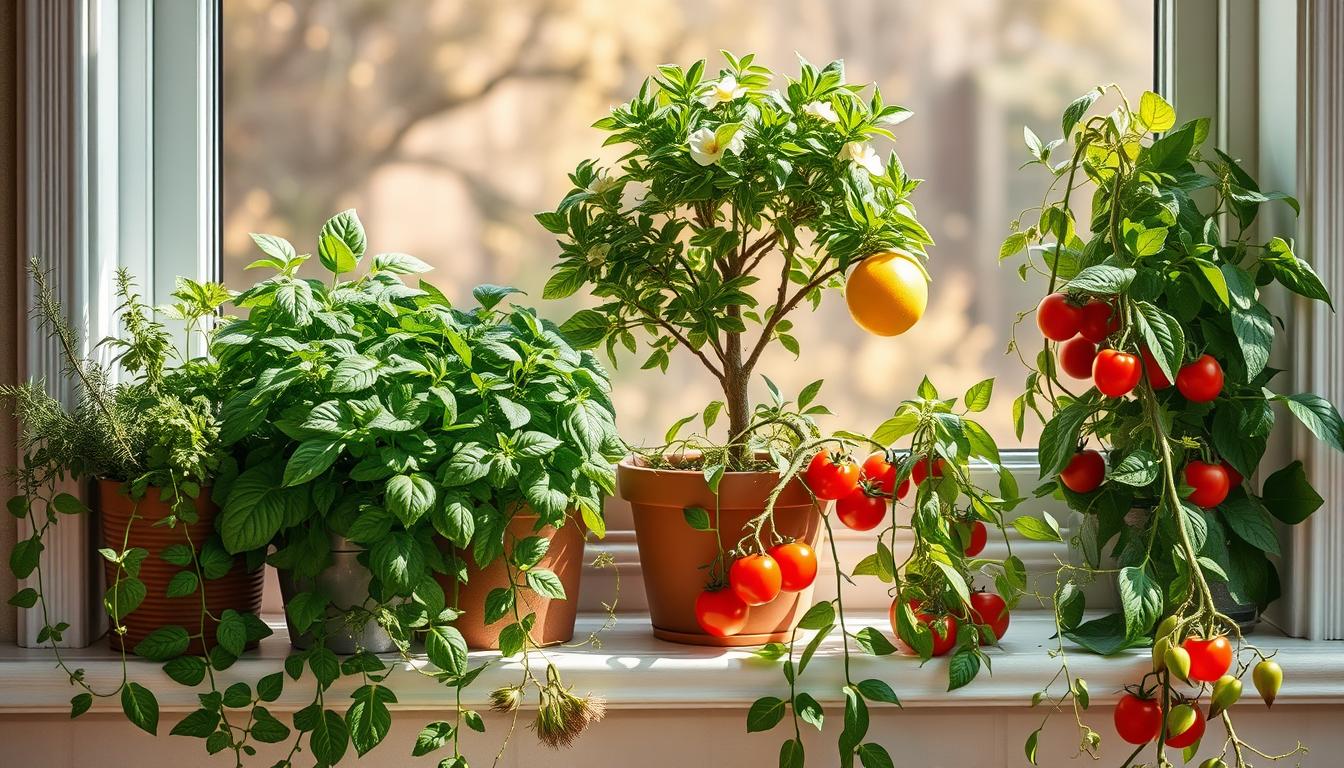Do you remember the joy of picking a ripe tomato from your garden? That feeling is now available to everyone, not just those with big backyards. Growing food indoors has become a popular choice for many Americans.
Kitchen gardening brings fresh produce right to your kitchen. It’s perfect for both big homes and small apartments. More people are finding it easy and rewarding to grow their own food at home.
Imagine snipping fresh herbs for dinner without leaving your kitchen. It’s not just convenient. It also saves the planet and gives you the best taste of fresh ingredients.
In this guide, we’ll cover easy options, space-saving ideas, and tips for a year-round indoor garden. You don’t need to be a gardening expert to start growing your own food at home.
The Joy of Harvesting Food from Your Windowsill
My indoor gardening journey started with a pot of basil on my kitchen windowsill. It quickly grew into a passion that changed how I see food. Watching seeds grow into plants at home is rewarding. It connects you to your food in a way shopping can’t.
My Personal Journey into Indoor Gardening
I remember my first herb garden attempt. It had basil, mint, and cilantro on my windowsill. The basil did well, but the mint spread too much, and the cilantro died fast.
Instead of giving up, I wanted to learn more. I read books and joined online gardening groups. Each failure taught me something new, like cilantro needs more space and mint needs its own pot.
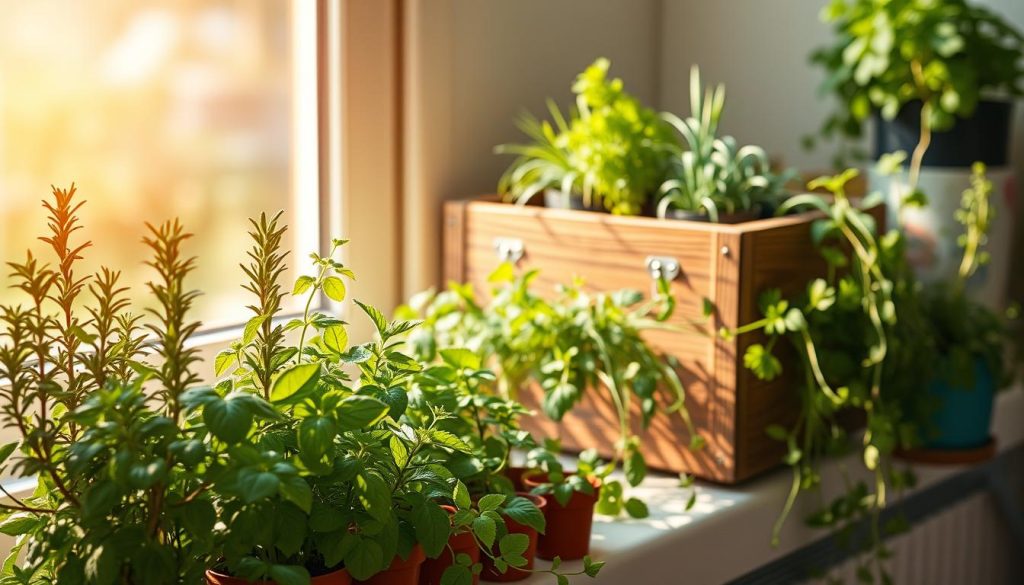
My collection grew over time. The kitchen window became a home for rosemary, thyme, and a second cilantro attempt. I also grew lettuce in old containers and harvested microgreens. It turned into a real passion for growing food indoors.
The Unexpected Satisfaction of Growing Your Own Food
My garden brought more than just fresh herbs. There’s pride in serving meals with herbs you’ve grown. Guests loved hearing that the basil came from my garden.
Growing your own food deepens your connection to it. Nurturing a plant from seed to harvest builds respect for your food. Even simple tasks like picking herbs become mindful moments.
My garden also became a therapy for me. After stressful days, I’d care for my plants. They needed attention, and in return, they gave me nourishment and a sense of achievement.
Why Edible Indoor Plants Are Revolutionary for Modern Living
Edible indoor plants are changing how we see food and our homes. They’re not just about gardening. They’re about making our living spaces more functional and sustainable. By growing food indoors, we make our homes healthier and more fulfilling.
Indoor gardens are special because they do two things at once. They give us fresh food and clean the air we breathe. This makes our homes into mini farms that help us live better.
Space Efficiency in Small Living Quarters
Indoor gardening is great for small spaces. Even tiny apartments can use vertical gardening to grow food. Window ledges and hanging planters make the most of every inch.
I’ve seen amazing things in small spaces. From herbs on kitchen windowsills to salad gardens on bookshelves. Even the smallest spaces can grow a lot of food with the right setup.
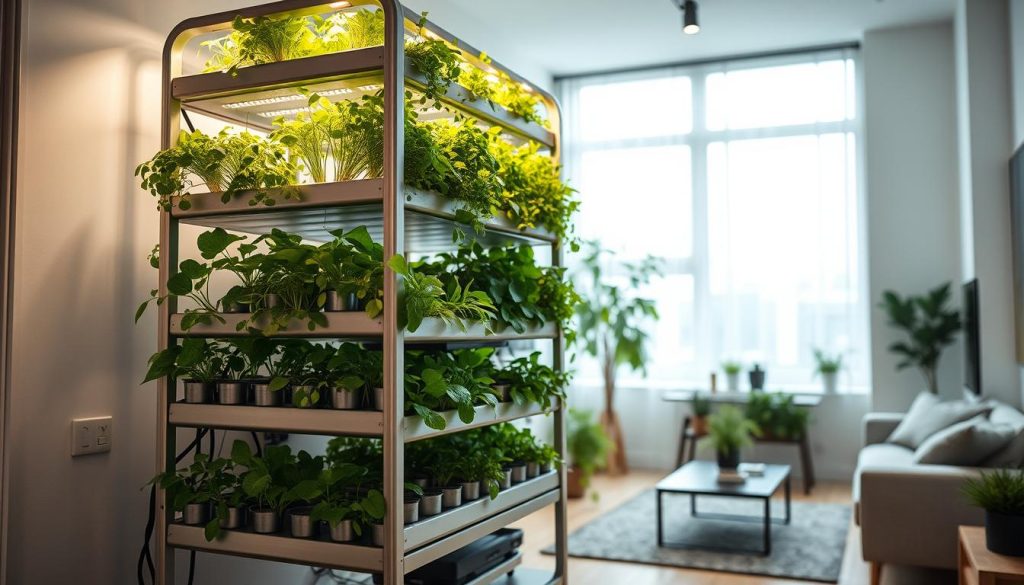
Edible plants are also beautiful. They can decorate your space while they grow. This is perfect for modern homes where everything must be useful.
Year-Round Growing Regardless of Climate
Indoor gardening is amazing because it doesn’t rely on the weather. Unlike outdoor gardens, indoor plants grow all year. This means we can have fresh food no matter the season.
In cold places, indoor gardens keep us eating fresh greens all winter. In hot places, they let us grow food even when it’s too hot outside. This makes food available all year, everywhere.
This means we can have food like strawberries in December and fresh basil in February. It’s not just a dream anymore.
Reducing Grocery Bills and Environmental Impact
Growing your own food indoors saves money. Herbs that cost a lot at the store can be grown at home for months. A small herb garden can save you $15-20 a week.
It also helps the planet. Store-bought food travels far, using a lot of energy. Growing your own food cuts down on this waste.
It’s also better for the environment because we use fewer chemicals and less packaging. This makes our food cleaner and our planet greener.
| Benefit Category | Traditional Grocery Shopping | Indoor Edible Gardening | Impact Level |
|---|---|---|---|
| Cost Savings | Recurring weekly expenses | Initial investment with ongoing returns | High for frequently used items |
| Environmental Impact | Transportation emissions, packaging waste | Minimal carbon footprint, zero packaging | Significant reduction |
| Food Quality | Days/weeks old at purchase | Peak freshness at harvest | Superior taste and nutrition |
| Air Quality | No impact | Plants filter indoor air pollutants | Moderate improvement |
| Food Security | Dependent on supply chains | Partially self-sufficient | Increased resilience |
Edible indoor plants change how we think about growing food. They make our homes more sustainable, save us money, and improve our health. They also make our homes look and feel better.
Best Edible Indoor Plants for Beginners
Edible houseplants are great for beginners. They can turn your windowsill into a garden. Starting with the right plants is key to success.
Herbs That Thrive on Windowsills
Herbs are a good start for indoor gardening. They need little space and grow well in containers. They also add flavor to your cooking.
Herbs are easy to care for. They can bounce back from neglect. If they droop, they need water. Yellow leaves mean they need nutrients.
Herbs also keep pests away. A small herb garden is easy to care for and rewarding.
Basil, Mint, and Rosemary: My Top Three
Basil is great for beginners. It grows fast and needs sunlight. You can harvest its leaves in 3-4 weeks.
Mint is hard to kill and grows fast. It needs moderate light and water. Rosemary is easy to care for and smells great.
Surprising Herbs Worth Trying
There are many herbs worth trying. Lemon verbena adds a citrus flavor to desserts. Thai basil has a unique taste.
Chervil grows in cooler light. Cuban oregano has thick leaves and needs little water. It tastes intense.
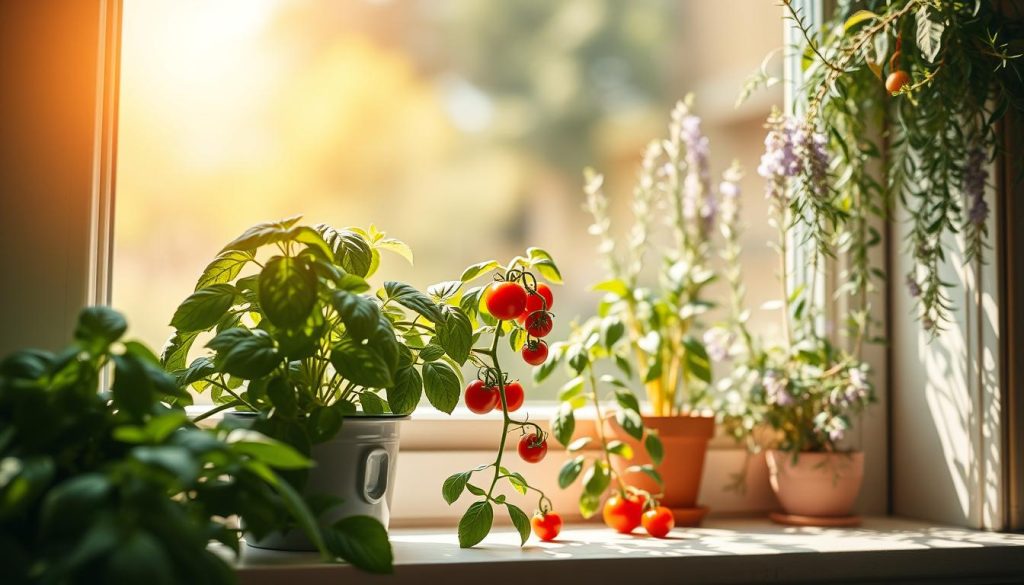
Leafy Greens for Continuous Harvesting
Leafy greens are great for indoor gardens. You can harvest leaves and let the plant grow more. This gives you fresh greens for weeks.
Lettuce and arugula grow fast and need less light. Spinach and kale are nutritious but take longer. Harvest them young for the best taste.
| Leafy Green | Days to Harvest | Light Needs | Watering Frequency | Special Notes |
|---|---|---|---|---|
| Loose-leaf Lettuce | 28-35 days | Medium (4-6 hrs) | Every 2-3 days | Harvest outer leaves first |
| Arugula | 21-28 days | Medium (4-6 hrs) | Every 2-3 days | Peppery flavor intensifies with age |
| Baby Spinach | 30-40 days | Medium-Low (3-5 hrs) | Every 3-4 days | Prefers cooler temperatures |
| Baby Kale | 30-40 days | Medium (4-6 hrs) | Every 3-4 days | More tender than mature kale |
Microgreens: Nutritional Powerhouses
Microgreens are perfect for quick results or small spaces. They are young plants harvested when small. They are packed with nutrients.
Microgreens are easy to grow. They need a shallow container, growing medium, and seeds. They are ready in 7-14 days.
Microgreens are space-efficient. A small tray can give you enough for salads or sandwiches. Harvesting your first crop is very rewarding.
Setting Up Your Indoor Edible Garden
Turning your indoor space into a food garden is exciting. It starts with knowing what you need for container gardening. Whether it’s a sunny spot or a dark corner with lights, planning is key. I’ve learned a lot over the years, and I’m eager to share my tips.
Container Selection and Creative Repurposing
Choosing the right containers is the first step. You can use traditional planters or get creative. I’ve grown herbs in mason jars and strawberries in hanging shoe organizers.
Think about the roots of your plants. Herbs like basil need shallow containers. Leafy greens and root veggies need more depth.
Make sure your containers drain well. Add holes or use pebbles at the bottom. For more space, try wall-mounted planters or tiered stands.
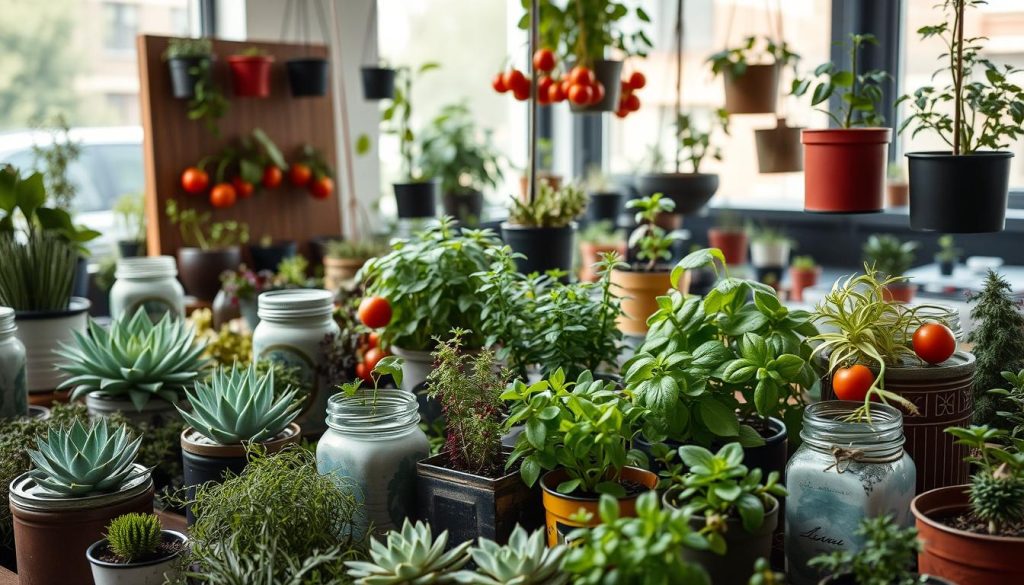
Soil Mixtures for Optimal Growth
Don’t use regular garden soil in containers. It’s too heavy and can harm your plants. Instead, use a potting mix made for containers.
For your plants, mix two parts potting soil, one part compost, and one part perlite or coconut coir. This mix keeps the soil healthy and drains well. Add worm castings for extra nutrients.
Container soil loses nutrients quickly. Refresh your mix every season or use organic fertilizers to keep your plants healthy.
Lighting Solutions for Different Spaces
Light is a big challenge for indoor gardeners. Most plants need 6 hours of good light daily. Knowing your space’s light is crucial.
Natural Light Optimization
South-facing windows are best for most plants. East and west windows are good for herbs and greens. North windows need extra light.
Use reflective surfaces to bounce light back. White foam boards or mirrors work well. Rotate your containers to ensure even light.
Artificial Lighting Options I Recommend
LED grow lights are great for low light areas. They’re energy-efficient and don’t get too hot. Start with simple clip-on lights for herbs and greens.
For more serious gardening, consider LED panel lights. They provide the full spectrum plants need. Place them 6-12 inches above your plants and give 12-16 hours of light daily.
Use timer switches to keep your plants on a consistent light schedule. This is crucial for plants that need specific light times.
Advanced Edible Indoor Plants for the Ambitious Gardener
If you’re ready to try new things in your indoor garden, there’s a world of advanced edible plants waiting for you. These plants need more care but offer unique harvests. Are you up for the challenge? Let’s look at some ambitious options to turn your home into a food garden.
Dwarf Fruit Trees That Flourish Indoors
Yes, you can grow fruit trees inside your home! Dwarf varieties are perfect for indoor growing and produce edible fruits. Meyer lemons are great indoors because they’re small and self-pollinating, offering sweet fruits all year.
Calamondin oranges are great for your kitchen with their small, tart fruits. Fig trees, like ‘Petite Negra’ or ‘Little Miss Figgy’, produce sweet fruits twice a year in sunny spots.
These trees need at least six hours of bright light a day. They take 1-3 years to produce fruit but are beautiful plants. Most stay under 4 feet tall when pruned, perfect for small spaces.
Vegetables You Didn’t Know Could Grow Inside
There are many surprising vegetables that can grow indoors. Cherry tomatoes like ‘Tiny Tim’ or ‘Red Robin’ are easy to grow and don’t need bees to pollinate. Just make sure they have support and enough light.
Hot peppers, like Thai chilies or ornamental peppers, add heat and beauty to your space. For root vegetables, try growing carrots in deep containers. Varieties like ‘Paris Market’ or ‘Thumbelina’ grow well in 12-inch deep pots.
Indoor vegetables often need hand pollination. Use a small paintbrush to transfer pollen. Choose varieties bred for container growing for the best results.
Exotic Edibles Worth Experimenting With
For a real challenge, try growing wasabi in a cool, humid spot. It’s hard but rewarding. Ginger and turmeric are easier to grow from grocery store rhizomes in well-draining soil.
Edible flowers like nasturtiums, pansies, and violets add gourmet flair to dishes. The “miracle fruit” plant (Synsepalum dulcificum) makes sour foods taste sweet when eaten.
| Advanced Edible Plant | Space Requirements | Light Needs | Time to Harvest | Difficulty Level |
|---|---|---|---|---|
| Meyer Lemon | 3-4 ft tall container | 6-8 hours direct sun | 1-2 years | Moderate |
| Cherry Tomatoes | 12-inch pot | 8+ hours bright light | 60-80 days | Easy-Moderate |
| Ginger | Wide, shallow container | Filtered light | 8-10 months | Easy |
| Wasabi | Medium container | Shade to partial shade | 18-24 months | Challenging |
| Fig Tree | Large pot (15+ inches) | 6+ hours direct sun | 1-3 years | Moderate |
Maintaining Your Edible Indoor Plants Throughout the Seasons
Keeping your indoor herb garden thriving means adjusting to each season’s needs. Unlike outdoor gardens, indoor plants face different challenges. These include changes in heating, air conditioning, and light. After trying many approaches, I’ve found ways to keep my plants healthy and productive all year.
Watering Techniques That Have Worked for Me
Watering is key to happy plants. I use bottom-watering, which is a game-changer. I place pots in a tray of water for 30 minutes. This lets the roots drink what they need without getting too wet.
In winter, when it’s dry from heating, I check the soil more often. A wooden chopstick in the soil tells me if it’s moist. For busy times, self-watering globes help my basil stay hydrated.
Summer’s air conditioning can make the air dry. I group plants by their water needs. This makes caring for them easier.
Fertilizing Schedules That Produce Results
Not all plants need the same food. My herbs do well with a half-strength organic fertilizer once a month. But leafy greens and fruiting plants need more.
I adjust my fertilizing based on the season. In winter, I feed less. In spring and summer, I feed more. Worm castings are my go-to for slow, odor-free nutrition.
Yellow leaves mean a plant needs more nitrogen. Purple leaves might need more phosphorus. Catching these signs early helps me feed them right.
Natural Pest Management Approaches
Preventing pests is my top strategy. I check new plants carefully and watch for early signs of pests like aphids and spider mites.
When pests show up, I use gentle solutions first. A water and dish soap spray works for most pests. For fungus gnats, letting the soil dry a bit helps get rid of them.
Planting basil with tomatoes keeps pests away from both. This natural method keeps my garden healthy without harsh chemicals.
Harvesting and Using Your Homegrown Produce
After weeks of caring for your kitchen plants, it’s time to enjoy the fruits of your labor. There’s magic in picking fresh herbs or vegetables you grew. It turns simple meals into special moments.
From seed to plate, your indoor garden’s journey ends when you use its produce. I’ll share tips on harvesting and using your plants, from the best times to pick to creative ways to use them in cooking.
When and How to Harvest for Maximum Flavor
Harvesting at the right time is key. Most herbs taste best just before they flower. For basil, pinch the top leaves to encourage more growth.
Mint and oregano should be picked in the morning, after dew but before it gets hot. Leafy greens like lettuce and spinach are sweetest when young. Use the “cut and come again” method to get more harvests.
Microgreens are ready when they have their first true leaves. Cut them just above the soil with clean scissors. Cherry tomatoes should be left on the vine until they’re fully colored and soft.
| Plant Type | Best Time to Harvest | Harvesting Technique | Signs of Readiness |
|---|---|---|---|
| Basil | Morning, before flowering | Pinch tops, leaving at least 2 sets of leaves | Bright green leaves, 6-8″ tall plant |
| Lettuce | Early morning | Cut outer leaves only | Full-sized leaves, before bolting |
| Microgreens | Any time of day | Cut just above soil level | First true leaves have formed |
| Cherry Tomatoes | Afternoon | Gentle twist or snip stem | Full color development, slight give when touched |
Preserving Your Abundant Harvests
When your plants produce more than you can use right away, don’t worry. Freeze herbs in olive oil for future meals. These cubes add flavor to soups and sauces.
Drying herbs is another great way to keep them. Hang them upside down in a dry, airy spot. Once dry, store them in airtight containers. You can also make powder from leafy greens for smoothies.
Make herb-infused vinegars and oils for gourmet flavors. Mix herbs with your base liquid and let it steep for a week or two before straining.
My Favorite Recipes Featuring Indoor-Grown Ingredients
Using your indoor plants in cooking is the best part. They add flavor to simple dishes. Even the simplest meals become special with fresh ingredients.
I’ve made many recipes that highlight the taste of homegrown produce. Fresh herbs mean you can use less, letting their natural flavors shine.
Quick Weeknight Dishes
On busy nights, I make simple dishes that let my garden’s flavors shine. Five-minute pesto is a great pasta sauce or sandwich spread. Herb-infused scrambled eggs are quick and delicious.
Microgreen-topped avocado toast is a fast and healthy lunch. Roasted veggies with fresh herbs, feta, and oregano make a tasty dinner.
Impressive Entertaining Ideas
When guests come over, I like to show off my plants in creative ways. Herb-infused cocktails are a hit. Try muddled basil in a gin and tonic or mint in a mojito. Edible flower ice cubes add a touch of elegance to drinks.
Goat cheese with microgreens and herb-infused honey is a crowd-pleaser. Custom herb oils make a fancy bread dipping station that highlights your garden’s flavors.
Common Challenges with Edible Indoor Plants and How I’ve Overcome Them
My journey with edible indoor plants has had its ups and downs. But, I’ve learned a lot and become a better urban farmer. Indoor container gardening needs creativity and flexibility. After trying many things, I’ve found ways to solve common problems that might stop beginners.
Dealing with Limited Light Conditions
Not enough light is the biggest problem for indoor gardeners. Most plants need 6 hours of direct sunlight a day. This is hard to get in many homes.
To solve this, I’ve set up a light rotation schedule. I move plants to get the most sunlight. Reflective surfaces like white foam boards or aluminum foil also help bounce light back to plants. For darker spots, I use affordable LED grow lights. They use little electricity and give the right light spectrum for plants.
Managing Humidity and Temperature Fluctuations
Indoor air, like in winter, can be too dry for plants. Windowsills also have temperature swings that stress plants. I’ve solved this by using humidity trays. These are shallow containers with pebbles and water under the plants.
Grouping plants together also helps keep humidity up. For temperature issues, I use insulating materials to protect plants from cold windows. In summer, I move sensitive plants away from hot windows.
Balancing Aesthetics and Functionality
Not everyone wants their home to look like a greenhouse. Making edible plants fit with home decor takes planning. Choosing containers that match your decor is key.
Vertical gardening has changed my urban farming. Wall-mounted planters and hanging baskets save space and look good. I also use decorative trellises for climbing plants. This turns them into living art that also grows food.
| Challenge | Budget Solution | Mid-Range Solution | Premium Solution |
|---|---|---|---|
| Limited Light | Reflective surfaces, rotation schedule | Basic LED grow lights | Full-spectrum smart lighting systems |
| Humidity Issues | DIY pebble trays, grouping plants | Small room humidifier | Automated humidity control system |
| Temperature Fluctuations | Insulating materials, strategic placement | Thermal plant mats | Climate-controlled growing cabinet |
| Aesthetic Integration | Decorative containers, plant stands | Wall-mounted planters, hanging systems | Custom built-in growing installations |
Embracing a Greener Lifestyle Through Indoor Food Gardens
My journey with edible indoor plants has grown into something amazing. They do more than just grow food. They also clean our air and fill our plates.
Many don’t know that herbs and veggies are great at purifying the air. They remove toxins while giving us fresh food.
Starting with a few plants on a windowsill can change everything. It makes us think differently about living sustainably. I now skip buying wrapped herbs at the store because I have fresh ones at home.
Every bit of packaging we avoid helps a lot.
For families, these gardens are a treasure trove of learning. My niece loves watching seeds turn into dinner on our counter. It teaches her where food comes from.
This connection to food production helps her appreciate our planet more.
Indoor gardening is easy to start. You don’t need fancy tools or a lot of space. Just a sunny spot and basic planters are enough. Begin with a few herbs and grow more as you get better.
As your plants grow, you might find other areas of your life getting greener too. This is the best part – a stronger bond with what we eat and our surroundings.

